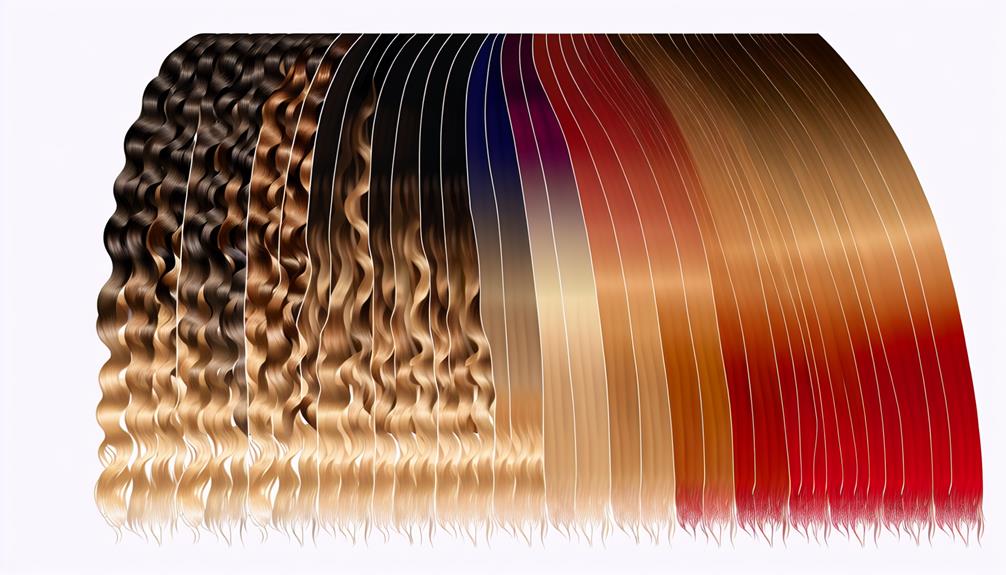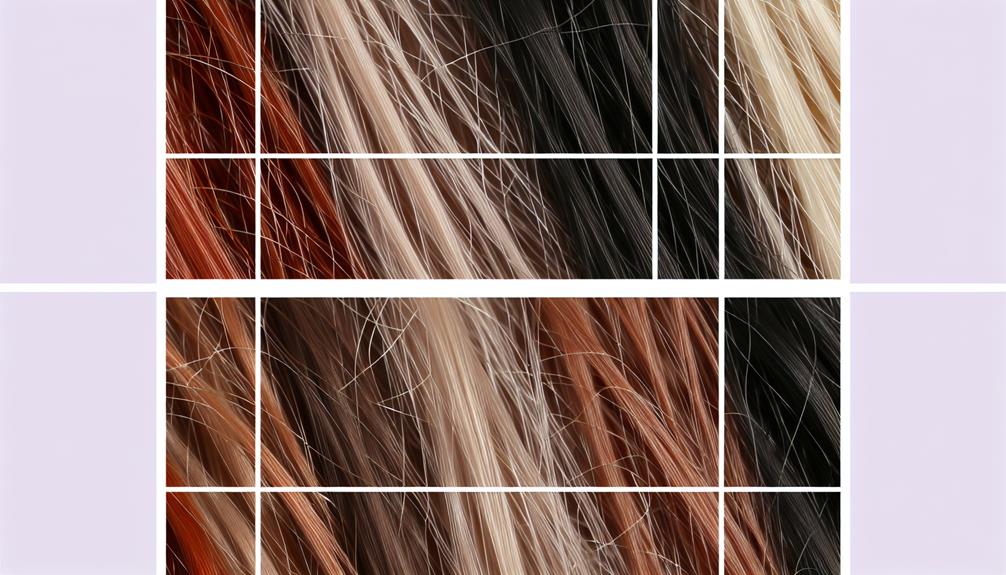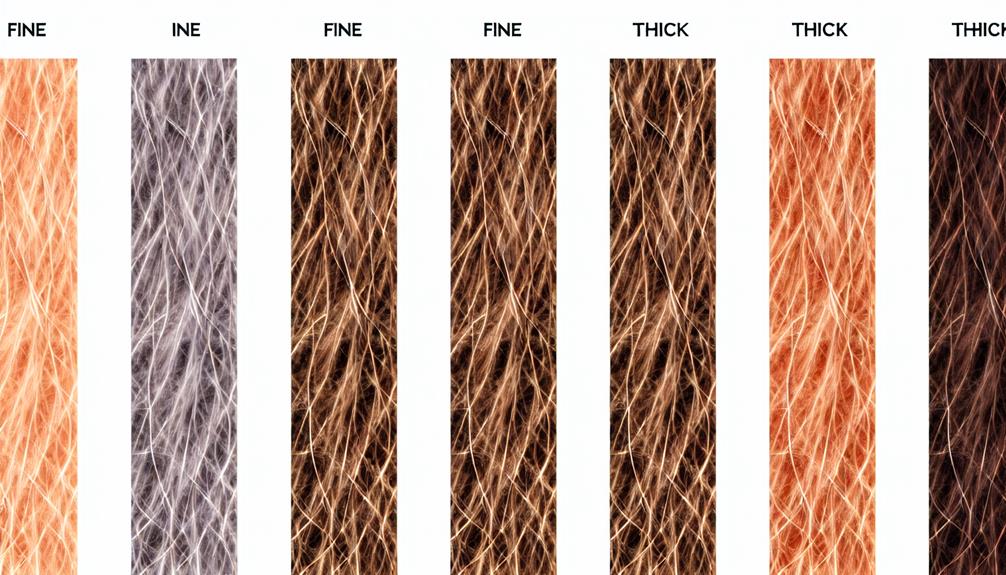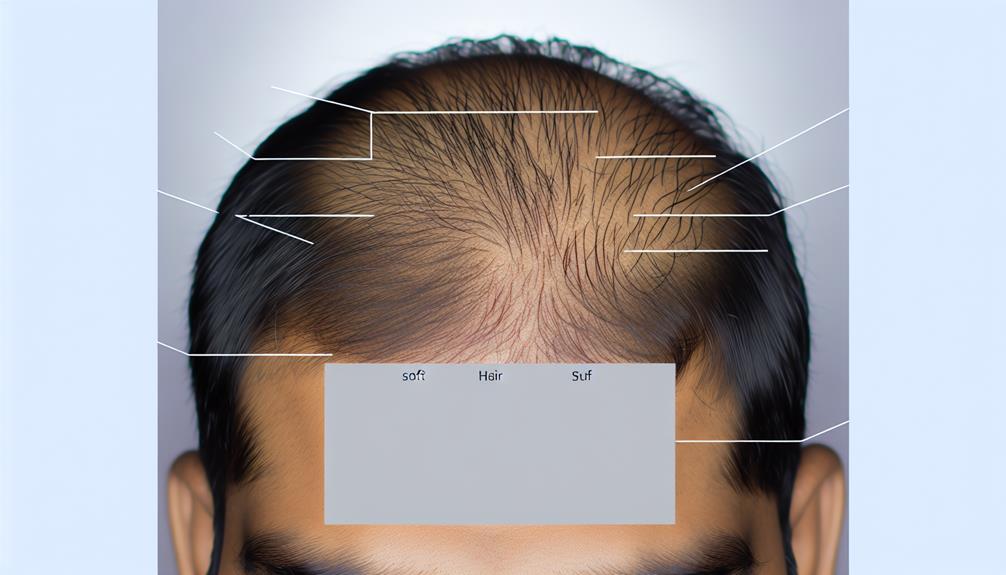Have you ever felt like you’re walking blindly through a hair care aisle, unsure of what products to choose for your specific hairtype? Well, fear no more! We’re here to shed some light on the mysteries of your hair.
In this discussion, we’ll reveal the secrets to figuring out what type of hair you have. From understanding the hair typing system to determining factors like porosity, density, scalp oiliness, and thickness, we’ll equip you with the knowledge you need to create a personalized hair care routine that will leave your locks looking their best.
So, if you’re ready to unveil the true nature of your hair, let’s dive in and discover the key to unlocking your hair’s potential.
Hair Typing System

Hair typing system, developed by stylist Andre Walker, categorizes different hair types based on their texture and curl pattern. This system is a liberating tool that allows us to understand and embrace the unique characteristics of our hair.
It celebrates the diverse beauty of curls, waves, and straight strands. The system defines nine hair types, ranging from straight hair to coily hair. Type 1 hair is straight, while type 2 hair is wavy with a slight curl pattern. Type 3 hair boasts beautiful ringlets, and type 4 hair showcases tight curls or kinky strands.
Determining Hair Porosity
To determine your hair porosity, you can easily conduct a strand test that reveals how your hair absorbs and holds moisture. Here are four steps to help you determine your hair porosity:
- Start by taking a clean strand of hair and placing it in a glass of water. If the hair sinks to the bottom, it indicates high porosity. High porosity hair absorbs moisture quickly but struggles to retain it.
- If the hair floats on top of the water, it indicates low porosity. Low porosity hair has a tightly sealed cuticle layer, making it resistant to moisture absorption.
- Another way to determine porosity is by running your fingers along a strand of hair. If it feels rough or bumpy, it likely has high porosity. Smooth and sleek hair indicates low porosity.
- Additionally, consider how your hair responds to products. If it takes a long time to dry or feels greasy quickly, it may have low porosity. If it dries quickly and requires frequent moisturizing, it may have high porosity.
Understanding your hair porosity will help you choose the right products and techniques for optimum hair care and moisture balance.
Understanding Hair Density

After determining your hair porosity, the next step in understanding your hair is to explore its density and how it affects your overall hair care routine.
Hair density refers to how much hair you have overall. It plays a crucial role in determining the thickness and fullness of your hair. If you can see your scalp between hair strands, it indicates less dense hair. On the other hand, a thicker ponytail, around 4 inches in diameter, suggests a higher hair density.
Understanding your hair density helps you choose the right styling products and manage volume effectively. Whether you have thin or thick hair density, embracing and celebrating your natural hair is a liberating experience.
Managing Scalp Oiliness
Excessively oily scalp can be a persistent issue for many, causing discomfort and affecting the overall health and appearance of our hair. Managing scalp oiliness is crucial in maintaining healthy and balanced hair. Here are four tips to help you combat excessive oiliness:
- Regular cleansing:
Wash your hair and scalp frequently using a gentle shampoo specifically designed for oily hair. This will help remove excess oil and buildup, keeping your scalp clean and refreshed.
- Avoid overwashing:
While it’s important to cleanse your scalp regularly, overwashing can actually strip your scalp of its natural oils, causing it to produce even more oil. Aim for washing your hair every other day or every two days to maintain a healthy balance.
- Use a clarifying shampoo:
Incorporate a clarifying shampoo into your routine once a week to deeply cleanse your scalp and remove any stubborn buildup. This will help prevent clogged pores and excessive oil production.
- Be mindful of styling products:
Avoid using heavy styling products or ones that contain oils, as they can weigh down your hair and contribute to oiliness. Opt for lightweight, oil-free products that won’t add to the problem.
Assessing Hair Thickness

Assessing hair thickness can be done by comparing the diameter of a single strand of hair with a piece of sewing thread. To determine your hair thickness, take a strand of hair and place it next to the thread.
If the hair strand is similar in thickness to the thread, then you have thick hair. Thick hair is full-bodied and can be easily felt between your fingers.
On the other hand, if the hair strand is thinner than the thread, then you have thin or fine hair. Thin hair lacks body and can be more difficult to style.
Understanding your hair thickness is crucial when it comes to choosing the right products and styling techniques to enhance the appearance and manageability of your hair.
Conducting a Strand Test
Now let’s move on to the next step in understanding your hair type and needs: conducting a strand test. This test will help you determine your hair’s porosity, which is crucial for choosing the right products and maintaining healthy hair.
Here’s how to conduct a strand test:
- Start by taking a clean, dry strand of hair from the back of your head.
- Fill a glass with room temperature water and gently drop the strand into the glass.
- Observe the strand for a few minutes. If it sinks to the bottom, your hair has high porosity. If it floats on the surface, your hair has low porosity.
- Repeat the test with a few more strands to ensure accuracy.
Understanding your hair’s porosity will allow you to tailor your hair care routine to meet its specific needs. So go ahead and conduct that strand test to unlock the secrets of your hair!
Interpreting Visible Scalp

To understand your hair density, it’s important to interpret the visibility of your scalp between hair strands. When examining your scalp, you may notice that your hair is spaced further apart, allowing your scalp to peek through. This indicates a lower hair density, where there are fewer strands per square inch.
On the other hand, if your hair is closely packed together, with minimal visibility of your scalp, you likely have a higher hair density.
Understanding your hair density is crucial because it affects the way you style and care for your hair. For those with lower hair density, using volumizing products and techniques can help create the appearance of fuller hair.
Those with higher hair density may need to focus on managing volume and preventing hair from looking too thick or weighed down.
Comparing Hair Strand With Thread
When comparing the thickness of your hair strand with a piece of sewing thread, you can determine whether you have thick or thin hair. Here’s how to do it:
- Get a strand of your hair: Take a strand of your hair and hold it between your fingers. Feel its texture and thickness.
- Compare it with sewing thread: Take a piece of sewing thread and place it next to your hair strand. Observe if they’re similar in thickness or if one is noticeably thinner than the other.
- Thick hair: If your hair strand is similar in thickness to the sewing thread, congratulations! You have thick hair. Thick hair is easier to feel between your fingers and often has more body and volume.
- Thin hair: If your hair strand is noticeably thinner than the sewing thread, you have thin or fine hair. Thin hair lacks body and can be more difficult to style.
Frequently Asked Questions
How Do Different Hair Types Affect the Choice of Styling Products?
Different hair types affect the choice of styling products in various ways. For example, straight hair may benefit from lightweight products that won’t weigh it down, while curly hair might require more moisturizing and defining products to enhance its natural texture.
Wavy hair may benefit from products that add volume and control frizz. Kinky hair may need rich, hydrating products to combat dryness.
Understanding your hair type is crucial in selecting the right products to achieve the desired results and maintain healthy, beautiful hair.
Can Hair Porosity Change Over Time?
Yes, hair porosity can change over time. Factors such as chemical treatments, heat styling, and environmental damage can alter the hair’s porosity.
For example, frequent use of heat tools can cause the cuticle to become more porous, while excessive exposure to the sun can make the hair less porous.
It’s important to regularly assess your hair’s porosity to determine the right products and techniques for optimal hair health and styling.
What Are Some Common Causes of Scalp Oiliness?
Some common causes of scalp oiliness include:
- Excessive production of sebum from the scalp, which can be influenced by factors such as hormonal changes, genetics, and environmental conditions.
- Certain hair care practices like using heavy or oily styling products, not properly cleansing the scalp, or over-washing can contribute to oiliness.
It’s important to find a balance and maintain a healthy scalp by using appropriate hair care products and practices that suit your specific needs.
Is Hair Density Solely Determined by the Number of Hair Strands?
Hair density isn’t solely determined by the number of hair strands. While the number of strands does play a role, other factors such as the thickness of each strand and the spacing between them also contribute to the overall density.
Thick hair strands and closely spaced strands can result in a higher density, whereas thin strands and wider spacing can lead to lower density. Understanding your hair density is important for choosing the right products and achieving your desired hairstyle.
Can Hair Thickness Be Increased or Changed Through Hair Care Products or Treatments?
Yes, hair thickness can be influenced by the use of hair care products and treatments.
Certain products, such as volumizing shampoos and conditioners, can help create the appearance of thicker hair by adding body and volume.
Additionally, treatments like keratin treatments and hair extensions can also enhance the thickness of the hair.
However, it’s important to note that these methods provide temporary results and may require ongoing maintenance to maintain the desired thickness.
Conclusion
In conclusion, understanding your hair type, porosity, density, scalp oiliness, and thickness is crucial for tailoring your hair care routine to meet your specific needs.
By knowing these key factors, you can select the right products and techniques to achieve optimal moisture balance, volume, and overall hair health.
So, don’t continue to guess what type of hair you have. Dive in and unlock the secrets of your hair today!





